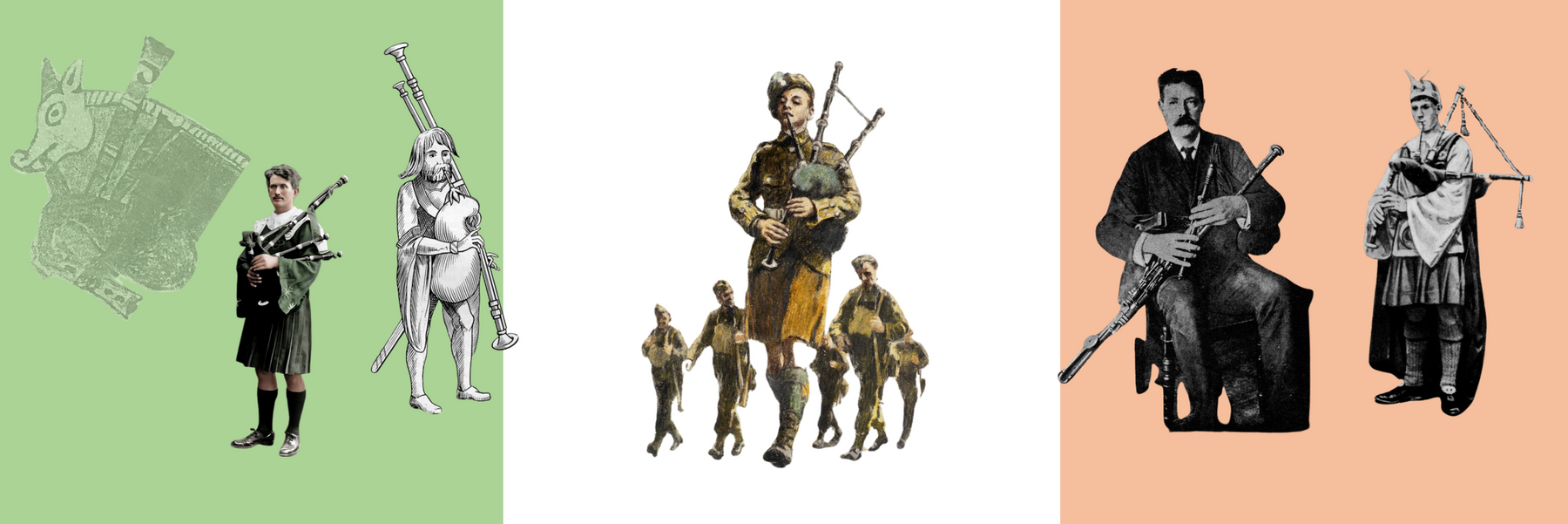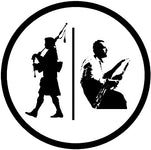
From Battlefields to Ballads: The Epic History of Irish Bagpipes
Key Points
-
Bagpipes in Ireland date back to 1206, likely introduced by Normans, with war pipes used in battles and uilleann pipes emerging later for folk music.
-
War pipes, mouth-blown and similar to Scottish Highlands bagpipes, were prominent in military contexts but declined after 1607, reviving in the 20th century with Scottish influence.
-
Uilleann pipes, bellows-blown and unique to Ireland, became central to folk music from the 18th century, surviving colonial suppression.
-
Today, uilleann pipes dominate traditional music, while war pipes thrive in military bands and competitions, reflecting a blend of Irish and Scottish traditions.
A Rich History of Irish Bagpiping
Bagpipes have been part of Ireland’s musical fabric for centuries, with a history that’s both deep and diverse. Here’s a straightforward look at the main types—war pipes and uilleann pipes—and how they’ve shaped Irish culture.
Early Beginnings
Bagpipes first appeared in Ireland around 1206, likely brought by Norman invaders after their 1169 invasion (Bagpipes Wikipedia). Early depictions, like those in John Derricke's 1581 The Image of Irelande, show mouth-blown pipes used in battles and ceremonies.
War Pipes: The Sound of Battle
War pipes, or “warpipes” as English writers called them, were loud, mouth-blown instruments used to rally troops during conflicts like the Nine Years’ War (1594–1603). They had two drones, unlike the three in Scottish Highlands bagpipes. Their use faded after 1607 with the collapse of Gaelic society, but they made a comeback in the 20th century, influenced by Scottish styles (Great Irish Warpipes Wikipedia).
Uilleann Pipes: Ireland’s Musical Heart
Around the late 1700s, uilleann pipes emerged, named for the Irish word “uille” (elbow) due to their bellows-driven design. Perfect for indoor settings, they became central to Irish folk music, played at gatherings and by traveling musicians. They evolved from English Northumbrian pipes, not the war pipes, and survived tough times like the Great Famine (Uilleann Pipes Wikipedia).
Revival and Modern Times
The late 1800s saw a Gaelic Revival, reviving interest in Irish culture. Figures like Éamonn Ceannt played uilleann pipes, while war pipes were readopted, forming bands like St. Lawrence O’Toole (1910) in areas with Scottish ties. Today, uilleann pipes shine in traditional music, and war pipes are heard in military bands and competitions (Irish Piping Blog).
A Surprising Twist: English Roots
It’s fascinating to learn that uilleann pipes, often seen as purely Irish, actually have roots in English designs, showing how cultures blended over time.
A Detailed Survey of Bagpiping Traditions in Ireland
The history of bagpiping in Ireland is a multifaceted narrative, reflecting cultural, social, and political shifts over centuries. This survey aims to provide a comprehensive account, drawing on historical evidence and scholarly insights, to trace the evolution of bagpiping traditions, their decline, revival, and modern significance.
Early Origins and Introduction
The earliest documented reference to bagpipes in Ireland dates to 1206, approximately thirty years after the Anglo-Norman invasion (1169–1171), suggesting their introduction by Norman forces or through their cultural influence (Bagpipes Wikipedia). This aligns with evidence that bagpipes were known in Britain post-Roman invasion (4th–5th century A.D.), potentially brought to Ireland via Anglo-Norman connections (Beth Roars: Truth About Bagpipes). Pre-Christian Ireland lacks references to bagpipes, with Brehon laws mentioning reed pipes ("cuisle") but not bagpipes, and early depictions like the 10th-century cross at Monasterboice showing bagless triple pipes, not true bagpipes (War Pipe History).
By the 13th century, bagpipes were mentioned at Holy Trinity Church, becoming more Gaelcised by 1375 with Donald O'Moghan's license, indicating their integration into Irish society (War Pipe History). The first pictorial representation, from John Derricke's "The Image of Irelande" (1581), depicts a two-drone mouth-blown pipe, similar to English and French variants, used in both civilian and military contexts (Bagpipes Wikipedia).
The Warpipes: Martial and Ceremonial Use
The mouth-blown bagpipes, often termed "warpipes" by English writers like John Derricke (ca. 1578) and Captain Edward Burt (ca. 1725), were associated with warfare. A likely first reference to their use in war appears in a manuscript (1484–1487) containing an Irish Gaelic version of "Fierabras," translating to "let horns and pipes be played to muster your troops" (Quora: Highland Bagpipes). During the Nine Years’ War (1594–1603), led by Hugh O’Neill, and later conflicts like the 1641 Rebellion and Williamite War (1689–1691), these pipes likely inspired Irish forces, though direct evidence is limited (Bagpipes Wikipedia).
The term "war pipe" was a misnomer, not used by the Irish themselves, and perpetuated by English accounts and later by Grattan Flood's 1911 book and the Irish Pipe Band Association around 1933 (War Pipe History). Their use declined after the Flight of the Earls in 1607, with the collapse of Gaelic arts, shift to indoor social life, and no legal proscription (e.g., Statutes of Kilkenny irrelevant), lasting about 250 years in Ireland, except in Ulster, and disappearing after 1600 (War Pipe History). The Great Irish Warpipes, with two drones, differed from the Scottish Great Highlands Bagpipe’s three drones (Great Irish Warpipes Wikipedia).
The Emergence of Uilleann Pipes
As warpipes waned, the uilleann pipes emerged in the late 17th or early 18th century, a bellows-blown instrument named after the Irish word "uille" (elbow), reflecting its operation. They evolved from English Northumbrian or pastoral pipes, not from the earlier mouth-blown pipes, and were quieter and sweeter, suited for indoor performances (Uilleann Pipes Wikipedia; War Pipe History). Early forms, called "Pastoral or New bagpipe" in Geoghegan's 1740s tutor, featured a conical bored chanter played legato, initially with two drones, later including regulators for harmonic accompaniment (Uilleann Pipes Wikipedia).
The uilleann pipes gained popularity within the Protestant Anglo-Irish community, used by gentlemen pipers, often clergy, as an alternative to church organs, with notable early players like Jackson from Co. Limerick (mid-18th century) and William Kennedy from Tandragee (Uilleann Pipes Wikipedia). The earliest surviving sets date from the second half of the 18th century, though datings are not definitive, and they became central to Irish folk music by the 19th century (Uilleann Pipes Wikipedia).
Other Bagpipe Types in Ireland
While war pipes and uilleann pipes dominate, other forms existed. Pastoral pipes, precursors to uilleann pipes, were simpler bellows-blown instruments popular in the 17th–18th centuries. Mouth-blown pipes, similar to war pipes, were used in some regions, especially during the Gaelic Revival, often adopting Scottish styles with three drones. These variations highlight Ireland’s diverse piping landscape, with regional differences in design and use, such as the two-drone war pipes versus the three-drone Scottish-influenced pipes in modern bands.
Decline and Colonial Impact
The 18th century saw a decline in bagpiping, exacerbated by British colonial policies suppressing Gaelic culture. The Great Famine (1845–1852) devastated rural communities, leading to emigration and loss of practitioners, though uilleann pipes persisted (Bagpipe History: Ireland). The mouth-blown pipe tradition was weak and easily abandoned, with no evidence of music, look, or pitch from the 16th century, likely dead by mid-19th century for over 150 years (Bagpipe History: Ireland).
The Gaelic Revival and Modern Resurgence
The late 19th-century Gaelic Revival, driven by nationalist sentiment, sparked renewed interest in Irish bagpiping. Figures like Éamonn Ceannt, a 1916 Easter Rising leader, played uilleann pipes, performing for Pope Pius X in 1908, elevating their cultural status (Irish Piping Blog). Simultaneously, Irish nationalists adopted Scottish-style Great Highlands Bagpipes, forming pipe bands, especially in Ulster, Mayo, and Donegal, with groups like the St. Lawrence O’Toole Pipe Band (founded 1910) still active (AskHistorians Reddit).
The reintroduction of mouth-blown pipes occurred in the 20th century, with Piobaireachd becoming a regular event at the annual Ulster contest in 1991, reflecting Celtic revival influences (War Pipe History). The Irish Army, from the founding of the Army School of Music in 1923, trained pipers for warpipe bands, playing mouth-blown pipes in saffron kilts at ceremonies and peacekeeping missions, such as in the Congo in the 1960s (Irish Piping Blog).
Modern Traditions and Cultural Significance
Today, bagpiping in Ireland encompasses two parallel traditions. Uilleann pipes, promoted by organizations like Na Píobairí Uilleann (founded 1968) (Na Píobairí Uilleann About Us), are central to traditional music, played by virtuosos like Séamus Ennis and Liam O’Flynn, and featured in global phenomena like "Riverdance" (Uilleann Pipes Wikipedia). They are cherished for their melodic complexity, often performed solo or with instruments like the fiddle or bodhrán.
Mouth-blown pipes, or Great Irish Warpipes, thrive in military and competitive contexts, with pipe bands performing at parades and events like St. Patrick’s Day. The National Museum of Ireland holds historic bagpipes, including those linked to Lord Edward FitzGerald (1798 Rebellion), highlighting their historical importance (Irish Piping Blog). Makers like T. Crowley & Son and institutions like the Cork Municipal School of Music sustain these traditions, ensuring their vitality (Irish Piping Blog).
Comparative Analysis and Insights
A notable insight is the discontinuity of the warpipe tradition, which, contrary to popular belief, was not a continuous Gaelic practice but rather introduced and later revived, with modern forms influenced by Scottish models. The uilleann pipes, often seen as quintessentially Irish, have roots in English and Northumbrian influences, challenging the notion of a purely native origin.
|
Aspect
|
Details
|
|---|---|
|
Earliest Mention
|
1206, post-Anglo-Norman invasion
|
|
First Pictorial Evidence
|
1581, in John Derricke's "The Image of Irelande"
|
|
War Pipes Decline
|
After 1607, Gaelic society’s collapse; dormant until 20th-century revival
|
|
Uilleann Pipe Rise
|
19th century, from English Northumbrian/pastoral pipes, bellows-fed
|
|
Gaelic Revival
|
From 1880, Anglo-Irish ties with Scotland spurred pipe bands
|
|
Modern Innovations
|
Army School of Piping (1923), three-drone pipes, Piobaireachd since 1980s
|
|
Myths Debunked
|
No Celtic origin, no Irish tartans, no bans—Hibernian dress a modern myth
|
This survey, drawing on sources like Frank J. Timoney’s "The Concise History of the Bagpipe" (Bagpipe History: Ireland) and Wikipedia entries, provides a rigorous foundation for understanding the evolution of bagpiping in Ireland, reflecting its resilience and adaptation through centuries of cultural change.
Key Citations:

Leave a comment